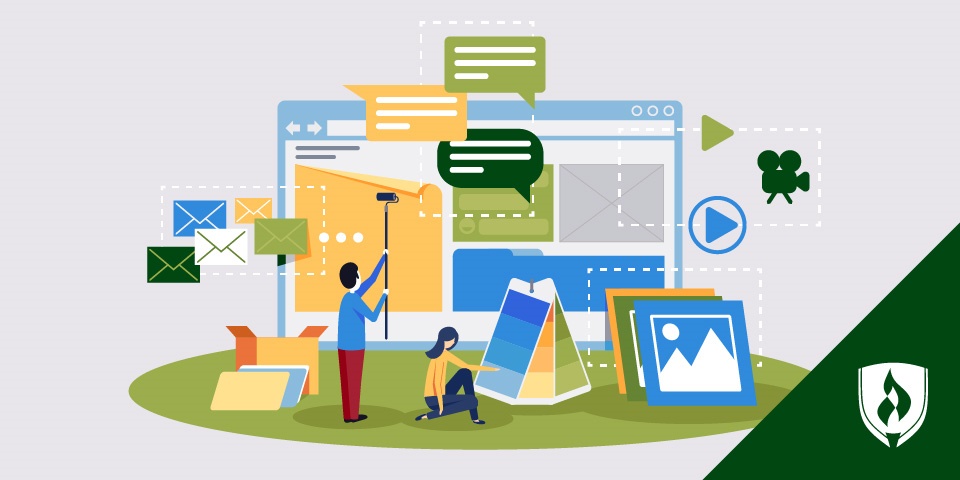
If you’re on your way to earning that web design degree, you’re probably starting to get a good grasp on the fundamentals of effective design. The knowledge and training you gain from each new course is helping prepare you for working in the field.
But if you’re looking for a little extra something to supplement your web design courses and set you apart from the others, you might want to consider honing in on an area that that has become increasingly important in the past year: user experience (UX) design.
So… What is UX design?
UX design goes beyond the basics of graphic design—it’s like design with a caffeine boost. This doesn’t just involve colors, fonts and symmetry. As the name suggests, UX design encompasses every aspect of a user’s experience within a design. This includes seven main components: usability, usefulness, desirability, value, findability, credibility and accessibility.
Successful UX allows a user to solve his or her problem as efficiently and seamlessly as possible. In fact, it’s often overlooked simply because it’s so effortless for the consumer. For the most part, the only time UX is noticed at all is when it has failed in some way.
Think of your favorite smartphone app …
Mobile applications are one of the biggest proponents of successful UX. People use apps every day to solve problems and improve efficiency. Let’s say you were in an unfamiliar city and wanted to find a great restaurant.
Without hesitation, you fire up the app to search for local establishments and are immediately presented with an impressive repertoire of candidates. After skimming patron reviews and perusing pictures of the entrée du jour, you finally land on a winner.
You enter a few details and reserve a table without even making a phone call. And with one last tap of the finger, a map appears to navigate you directly to your destination. Before you know it, you’re devouring the specialty dish you just read about.
How simple was that? The smooth journey that brought you from problem to solution was intricately developed by a team of UX designers. This is the magic that happens behind closed doors, and you could be a part of it!
UX designers must not only master the visual element of the design, but also the interactive elements that make for a great overall experience. Graphic designers create a one-way relationship between the product and the user, but UX designers must maintain a mutual interaction between the product and the user.
Where can you learn more about UX design?
If the idea of UX design sparks your interest, check out the eight resources we’ve compiled for your reference. Your courses are helping provide you with the fundamentals of web design, but a little exploration of your own in an area that piques your interest may just give you that extra something that will set you apart from the crowd after graduation.
1. Getting Started in UX Design, UXapprentice.com
Why you should care: This is a great starting point for anyone interested in learning more about UX design. The site uses a step-by-step process to illustrate the fundamentals of UX design.
By including real-life examples, the site breaks down a rather complex process into bite-size, easy-to-understand portions. It includes periodic questions to test your knowledge and determine if you understand the information. It also directs you to other helpful resources to further complement your learning.
2. What is User Experience Strategy, Anyway?, Archer-Group.com
Why you should care: Defining a UX strategy is the very first step in designing an experience, according to blogger and UX strategist, Catriona Cornett. She explains the importance of defining the components, benefits and deliverables before getting her hands dirty in the design process.
The article outlines the primary components of UX design strategy. Interactive visuals are included as well to help you grasp the concepts. For a more in-depth look into Cornett’s ideas, check out her free PDF.
3. Designing for the Multifaceted User, SmashingMagazine.com
Why you should care: UX strategist and researcher, Stephanie Troeth, shares her thoughts on the multifaceted nature of users. She believes that current UX tools are too heavily focused on who the users are, rather than how they react.
Throughout the article, she challenges designers to focus their efforts on predicting user reactions and designing accordingly. She also shares a few handy techniques to help streamline the process.
4. 7 Core Ideas About Personas and the User Experience, MeasuringUsability.com
Why you should care: A majority of UX designers use personas to assist them in their process. Personas are fictional characters created to epitomize different types of users within a targeted demographic.
Personas help designers get inside the mind of their audience, which in turn helps them create solutions specific to their precise needs. Usability engineer and statistical analyst, Jeff Sauro, reveals seven ideas about personas that he feels every UX designer should understand.
These thoughts help define the role of personas in UX design, while correcting some misconceptions about their use. Sauro outlines the benefits of this method as well as identifying some specific questions that should be answered throughout the process.
5. Lessons We Learned from Our Biggest UX and Design Mistakes, SixRevisions.com
Why you should care: Just as it’s important to study best practices, it’s just as valuable to learn what not to do. This article gives you a rare, behind-the-scenes look at the UX design efforts of Buffer co-founders Leo Widrich and Tom Moor. Buffer is an application that helps users share content and ideas more efficiently on social media networks.
The two speak candidly about the inspiration behind their product and lessons they learned along the way. They reveal their mistakes and share exactly how they converted those negatives into positives.
6. Are You a UX Statistic?, VitaminTalent.com
Why you should care: Did you know that 97% of websites fail at user experience? That is just one of the revelations included by the team at Vitamin T in this interactive infographic that highlights the significance of UX design.
The amusing data visualization takes you on a journey featuring many important factors that are all intertwined in UX design. This includes user testing, customer retention, avoidable spending and the ROI of UX design.
7. The ROI of User Experience, Human Factors International
Why you should care: Those unfamiliar with UX design may be asking, “Is it really worth it?” Well, this short—yet informative—video addresses just that. Dr. Susan Weinschenk, chief of UX strategy at Human Factors International, explains the return on investment (ROI) of user experience.
The video is engages its audience by including fun illustrations to accompany the information being shared. Weinschenk uses real-life examples to demonstrate the importance of UX design. Her statistical break-downs will open your eyes to the invaluable nature of UX design efforts.
8. A Guide to UX Careers, OnwardSearch.com
Why you should care: As an individual who is considering a career in UX design, this is a great asset to assist you in your job research. This infographic is jam-packed with information pertaining to jobs in this field.
If you want to learn about the types of positions available in the industry, you can find job descriptions, responsibilities and salary information all in one spot. You’ll also learn about the hottest locations for UX jobs and the skills you’ll need to succeed in the industry.




